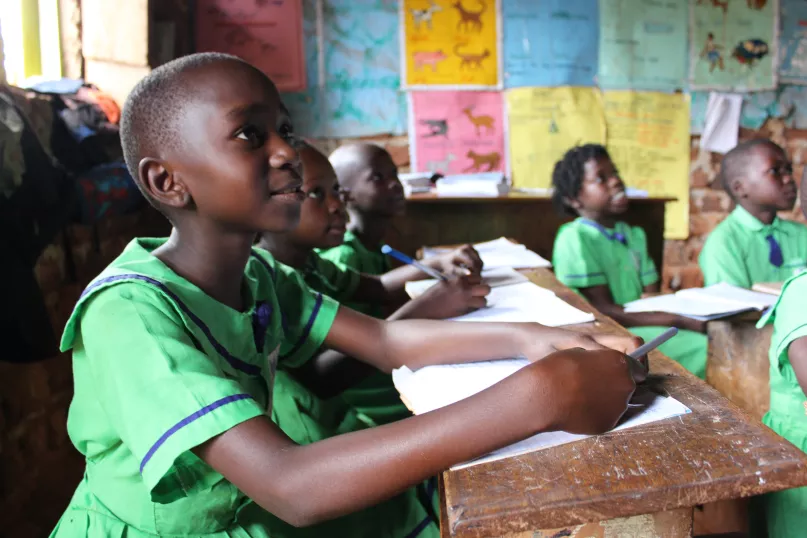Data Science Brings Education Finance to More Families

Once proclaimed a runaway success, "Education For All" initiatives around the world have crumbled under pressure to achieve real sustainability. Despite skyrocketing numbers of enrollees on the first day of primary school, hidden costs, low-quality education, lack of seats, unstable foreign aid, and poor system planning have shot dropout rates through the roof.
Take Uganda as a case in point.
UNESCO projects that no less than 68% of children who enroll in primary education in Uganda will drop out prior to finalizing their primary cycle. 700,000 Ugandan children have never even stepped foot in a classroom. There is a tremendous need not only for improved quality, but also for legitimate access to an education for many of Uganda’s youth.
So what do we do about this?
Opportunity International’s Education Finance unit has embarked on a unique solution, with funding from the Bill & Melinda Gates Foundation: leveraging Opportunity’s deep experience in offering pro-poor credit to low-income families – and the schools that they attend – to ensure access to education is never in question.

The education funding gap
Opportunity’s Education Finance portfolios in Uganda have provided 58,000 loans to families seeking tuition and school administrators who want to improve or expand their schools. But the need is far greater. Our market intelligence suggests that the need among low-cost private education providers, as well as low-income families with students attending both public and private educational institutions, is around USD 534 million annually. Meanwhile, microfinance institutions in Uganda – the segment of financial institutions that would typically serve this clientele if they had the capability – currently have the capacity to support a maximum of only USD 57 million (calculation assuming a maximum 10% balance sheet allocations to the education sector amongst all active MFIs in the market, based on publicly available data), leaving a funding gap of USD 477 million.
So what keeps bigger balance sheets from delving into the low-cost education lending space, and closing the funding gap? Oftentimes it is both a misunderstanding of financial viability of the low-cost market, as well as a lack of knowledge about potential borrowers.
In fact, the vast majority of education borrowers at Opportunity Bank of Uganda lack a profile within the domestic credit bureau, which is the key point of entry for commercial borrowing. Why? Low-income borrowers’ transactions are not large enough to merit the cost of registration by the lending bank, or for that matter, an attempt to pull their data.
Sharing Opportunity’s Education Finance model
Yet for more than five years, Opportunity’s Education Finance portfolios in Uganda have produced sustainable financial returns lending to these borrowers, with defaults well below 1%. This has been achieved while targeting an average loan size of just USD 240 for families and just over USD 10,000 for educational institutions, without running any form of credit-bureau checks.
Opportunity estimates that this lending has resulted in the creation of 36,000 new seats in low-cost education, 12,000 new jobs in the sector, and more than 365,000 new child-years of education preserved that otherwise would have been lost.
With such promising results, and so much more left to do, Opportunity International now wishes to share its lending model with other for-profit banks, microfinance institutions and nonprofit service providers. Opportunity International alone will not be able to meet the sizeable demand in the Ugandan market. Therefore, our next challenge is this: how do we export this Education Finance model from microfinance into mainstream commercial finance? Effectively doing so will serve to close the USD 477 million funding gap for pro-poor, low-income education growth.
For us, the answer lies in data science, combined with a systematization of Opportunity’s client-facing practices in education.
Using algorithms to provide access to education finance
Utilizing thousands of historical transactions, and dozens of related data fields per transaction, Opportunity and its partners have developed credit algorithms specifically designed to be responsive to applicants who, under normal circumstances, would not traditionally qualify for credit through commercial institutions.
We have created two series of algorithms: one focused on lending into low-cost schools, and the other focused on lending to parents for school fees. These are adapted to the lending environment as well; for example, there is one algorithm for group-based school-fee lending, and another for individual borrowers, as our data has demonstrated different borrowing behavior between the two types of borrowers.
These algorithms are designed to remove most of the guesswork from lending to low-income businesses and families. Even still, it is impossible to automate 100% of the interaction - particularly when lending to low-cost schools.

More than just algorithms
As a result, we have also crafted a comprehensive manual for the sales, monitoring, and promotion of Education Finance lending products, offered to each financial institution in Uganda. This is delivered alongside a comprehensive staff training program for the financial institutions that agree to launch a portfolio servicing low-income schools and families.
While we offer both the technical assistance and the algorithms to Ugandan financial institutions, the licensing of these algorithms is restricted to financial institutions that commit to using them to achieve an aim of financial inclusion and to price products fairly. The present cohort of implementing financial institutions is open to five total participants, with two remaining slots.
Algorithms are facilitators of financial inclusion. With the right partners, including a relevant delivery channel (such as a mobile money platform) and significant bank balance sheets, this algorithm-based education finance model has the potential to make significant gains in bringing education to those who are currently excluded from education, or are one paycheck away from being excluded.


